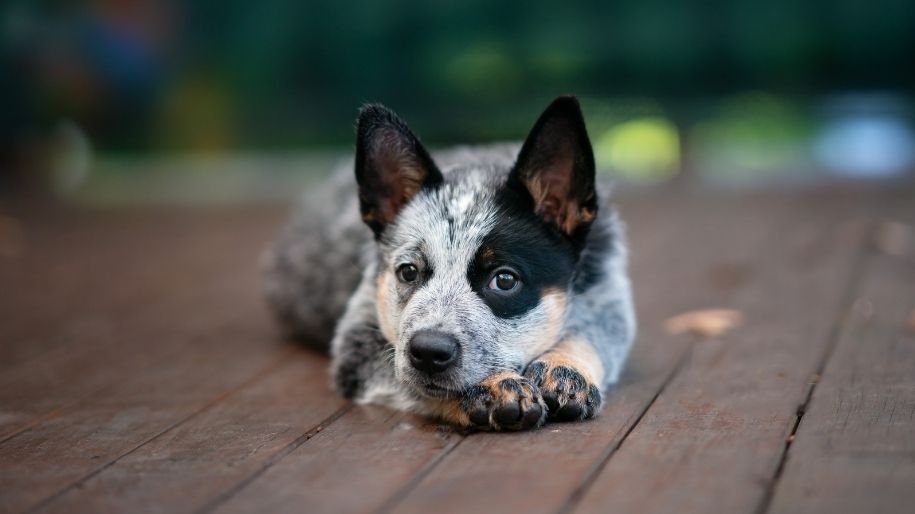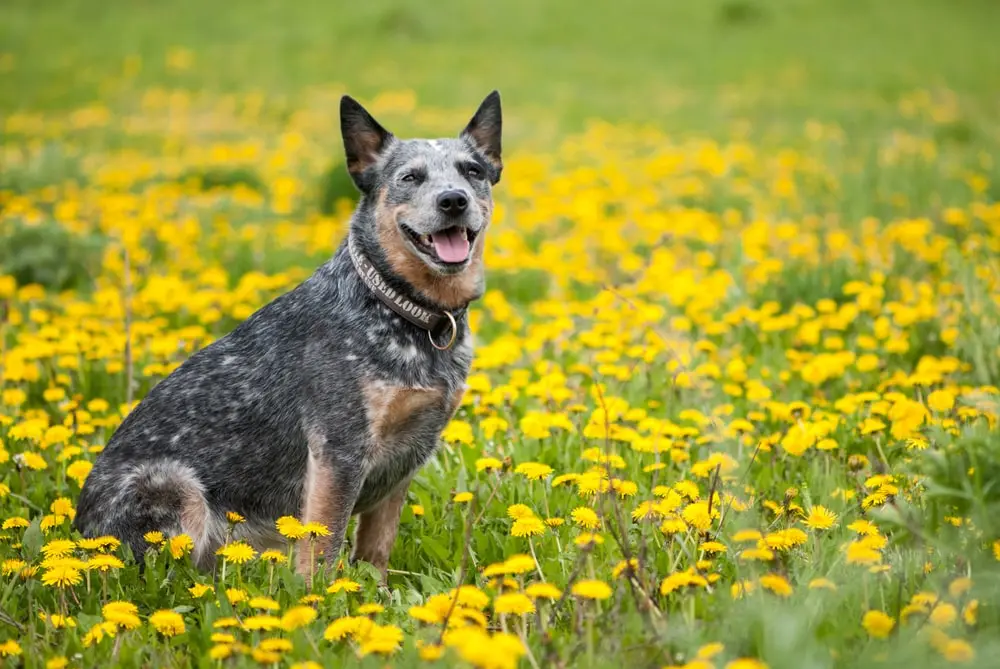BREED SPOTLIGHT
Breed Spotlight: Australian Cattle Dog
Australian Cattle Dog Quick Stats
LIFESPAN:
12 – 16 years
WEIGHT:
35 – 50 lbs
HEIGHT:
17 – 20 inches
DO I SHED?
somewhat
Personality:
watchdog, high energy, trainable, curious, intelligent, affectionate
Common Health Problems:
deafness, progressive retinal atrophy, hip dysplasia, Pelger-Huët anomaly
Australian Cattle: How Do I Look?
The Australian Cattle Dog is muscular but not large, topping out at just under 2 feet tall at the shoulder. Their smooth, short coats come in mottled blue with tan to dark markings.
Coat Type and Colors
Australian cattle dogs have short, smooth coats with a dense undercoat. Their most common coloration is a light grey known as “blue.” Because of this, Australian cattle dogs are also known as the blue heeler dog. The blue is often mottled with black and tan, with darker markings on the face. Some cattle dogs develop a red coat instead — these are known as the red heeler dog.
Ears
Cattle dogs have moderately-sized, wide-set ears. Like most dogs, their ears can be highly expressive, perking up when alert.
Shedding and Grooming
With their short coat, Australian cattle dogs can get by with a weekly brushing and occasional bath. They shed their undercoat twice a year, during which they’ll need a thorough brushing every few days.2
Drooling Level
These dogs rarely drool, making them less prone to creating messes on furniture and fabric.
Cattle Dogs: Personality Traits
What My Adoption Bio Would Say:
Searching for your one true partner? If we match, I’ll be your ride or die! There’s nothing I love more than my family, except maybe exercise. Whether it’s on the farm or on a jog with you, I’m always looking for ways to stay active and have fun. Hope you don’t mind a competitive streak! Whatever comes my way, I always give 100%.
Behavior
True to its name, the Australian cattle dog is highly energetic and task-driven. They love to play, run, and perform, making them excellent partners for athletic pet owners. Cattle dogs are also extremely loyal and, once adopted, will be by your side for life. Just make sure to keep your cattle dog occupied, or they might get into some mischief.
Exercise Needs
The Australian cattle dog is a veritable dynamo. Odds are, their exercise needs will outlast yours. Cattle dogs need more than just a daily walk and playtime to stay happy. Structured activities, like an agility course, are recommended for these bundles of boundless energy.
Good with Other Pets?
This breed will get along with most other dogs, but early socialization is key. Their herding instinct could come out as bossiness, which might upset playmates.
Trainability
It’s no surprise that cattle dogs are highly trainable. They were bred for a life of herding cattle. Their intelligence means they’re excellent at following orders. Early obedience training is a must if you want to forge a strong bond and keep your Australian cattle dog out of trouble.
Good with Kids?
Cattle dogs can be highly loyal and protective once bonded with their family. High energy and a trickster streak means they might clash with younger children, however. Australian cattle dogs do best with kids aged 10 and older.
Barking Level
Even without obedience training, the Australian cattle dog rarely barks. They are by nature watch dogs, however, meaning they’ll let you know when strangers approach.
The Australian Cattle Dog: A History
The cattle dog is as Australian as its name. Its ancestry is directly tied to the history and nature of the continent from Down Under.
The Hall family came to New South Wales with the goal of establishing a cattle ranch.2 At the time, Old English sheepdogs were the most common type of working dog in the Australian colonies. Thomas Hall found their performance lacking, however. He imported Northumberland Blue Merle drovers dogs and crossbred them with domesticated dingoes, the wild dog that roams the Australian outback. By 1840, Hall had established a new breed, called Halls heelers, used exclusively on the Hall ranch. Not until 1870 would the Heelers be more widely distributed across the continent.
The Cattle Dog Club of Sydney coined the name “Australian cattle dog” in 1890. This hard-working breed made its way to the United States in the 1950s, brought by World War II veterans returning from deployment in Australia. It wasn’t until 1980, however, that the American Kennel Club officially recognized the Australian Cattle Dog. Kennel clubs in Canada and the United Kingdom quickly followed suit.
Common Breed Name Mixes
- Cattle shepherd: Australian cattle dog German shepherd mix
- Pit heeler: Australian cattle dog pitbull mix
- Border heeler: Australian cattle dog border collie mix
Australian Cattle Dog Health Problems
- Hip dysplasia4
- Progressive retinal atrophy5: a group of retinal diseases that result in gradual blindness
- Deafness
- Pelger-Huët anomaly6: a rare blood condition marked by abnormal white blood cells
- Hypothyroidism7
- Elbow Dysplasia8: abnormal development of the elbow joint
Protect your Pets
Even the healthiest of pups can come with unexpected vet costs. Pet insurance can help keep your dog and your bank account happy.
How Pet Insurance Can Help Australian Cattle Dogs
Australian cattle dogs may be prone to several potentially costly health problems, including:
Deafness
Many breeds, including the Australian cattle dog, experience deafness. There can be multiple causes, from obstructions in the ear to cancer. As a purebred, cattle dogs may develop deafness as a genetic condition. Scientists have also identified a link between white-colored coats and deafness. If your cattle dog develops deafness later in life, your vet will likely catch it during a routine exam. Depending on the cause, medical or surgical intervention may be able to help. If not, there are steps you can take — such as training with hand signals — to ensure your cattle dog still enjoys a healthy life.
Pelger-Huët Anomaly
This rare hereditary condition affects the white blood cells of cattle dogs. Hypersegmentation causes the cell nucleus to have only two lobes, or no lobes at all. This condition is almost always benign, causing no known health issues in adult cattle dogs. (The exception, known as a homozygous anomaly, occurs while in utero and is typically lethal before the dog is born.) However, breeders are working to eliminate the anomaly from the Australian cattle dog line. Diagnosis can be done via a routine blood test as part of a wellness exam. This is typically performed as part of a standard examination and may be covered under a dog insurance policy from MetLife Pet.1
Elbow Dysplasia
Canine elbow dysplasia involves abnormal bone growth, cartilage development, and/or joint stress in the elbow joint of younger Australian cattle dogs. Symptoms include lameness in the affected limb, as well as secondary symptoms like weight gain. Vets typically use physical exams, x-rays, and CT scans to diagnose elbow dysplasia. They may prescribe joint supplements, anti-inflammatory medication, and joint fluid modifiers. Other approaches, like weight loss and physical therapy, can also help treat elbow dysplasia. If the joint has undergone severe degeneration, your vet may recommend corrective surgery. Consider a dog insurance policy while your Australian Cattle Dog is a puppy before elbow dysplasia becomes a preexisting condition.
Still uncertain if your cattle dog needs an insurance policy? Our guide to pet insurance helps explain how a policy can keep your dog (and your wallet) happy and healthy.






